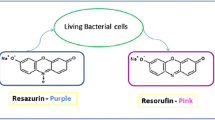Abstract
A disseminating strain ofNeisseria gonorrhoeae was grown in a liquid, defined medium containing different levels of a strong chelator of ferric iron, ethylenediamine-di (o-hydroxyphenyl acetic acid) (EDDA). The inhibition of growth produced by EDDA was relieved by addition of iron. Filtrates from cultures grown in the media deficient in iron were examined for presence of siderophores, microbial chelators of iron, by colorimetric tests for phenolates and hydroxamates and by two biological assays in which the filtrates were tested for ability to stimulate growth of small inocula and for ability to prevent bactericidal effects of normal human serum. By use of these methods, none of the filtrates displayed evidence of gonococcal siderophores.
Similar content being viewed by others
Literature Cited
Bullen, J. J., Rogers, H. J., Griffiths, E., 1974. Bacterial iron metabolism in infection and immunity, pp. 517–551 In: Neilands, J. B. (ed.), Microbial iron metabolism. New York, London: Academic Press.
Halmann, M., Mager, J., 1967. An endogenously produced substance essential for growth initiation ofPasteurella tularensis. Journal of General Microbiology49:461–468.
Hantke, K., Braun, V., 1975. Membrane receptor dependent iron transport inEscherichia coli. FEBS Letters49:301–305.
Lankford, C. E., 1973. Bacterial assimilation of iron. Chemical Rubber Company Critical Reviews in Microbiology2:273–331.
L'Eplattenier, F., Murase, I., Martell, A. F., 1967. New multidentate ligands. VI. Chelating tendencies ofN,N′-di(2-hydroxybenzyl)ethylenediamine-N,N′-diacetic acid. Journal of the American Chemical Society89:837–843.
Miles, A. A., Khimji, P. L., 1975. Enterobacterial chelators of iron: Their occurrence, detection, and relation to pathogenicity. Journal of Medical Microbiology8:477–490.
Neilands, J. B., 1966. Naturally occurring non-porphyrin iron compounds, pp. 59–108. In: Jorgensen, C. K., Neilands, J. B., Nyholm, R. S., Reinen, D., Williams, R. J. P. (ed.), Structure and bonding, vol. 1. New York: Springer-Verlag.
Neilands, J. B., 1974. Iron and its role in microbial physiology, pp. 4–34. In: Neilands, J. B. (ed.), Microbial iron metabolism. New York, London: Academic Press.
Norrod, P., Williams, R. P. 1978. Effects of iron and culture filtrates on killing ofNeisseria gonorrhoeae by normal human serum. Infection and Immunity21:918–924.
O'Reilly, R. J., Welch, B. G., Kellogg, D. S. Jr. 1973. An indirect fluorescent antibody technique for study of uncomplicated gonorrhea. II. Selection and characterization of the strain ofNeisseria gonorrhoeae used as antigen. Journal of Infectious Disease127:77–83.
Payne, S. M., Finkelstein, R. A., 1975. Pathogenesis and immunology of experimental gonococcal infection: Role of iron in virulence. Infection and Immunity12:1313–1318.
Payne, S. M., Finkelstein, R. A., 1978. Role of iron in disseminated gonococcal infections. Infection and Immunity20:573–574.
Payne, S. M., Finkelstein, R. A., 1978. The critical role of iron in host-bacterial interactions. Journal of Clinical Investigation61:1428–1440.
Rogers, H. J.. 1973. Iron-binding catechols and virulence inEscherichia coli. Infection and Immunity7:445–456.
Rosenberg, H., Young, I. G., 1974. Iron transport in the enteric bacteria, pp. 67–82. In: Neilands, J. B. (ed.), Microbial iron metabolism. New York, London: Academic Press.
Weinberg, E. D., 1978. Iron and infection. Microbiological Reviews42:45–66.
Wood, D. O., Brownell, G. H., 1975. Transformation of leucine and rifampin traits inNeisseria gonorrhoeae with deoxyribonucleic acid from homologous and heterologous origins. Journal of Bacteriology121:471–474.
Author information
Authors and Affiliations
Rights and permissions
About this article
Cite this article
Norrod, P., Williams, R.P. Growth ofNeisseria gonorrhoeae in media deficient in iron without detection of siderophores. Current Microbiology 1, 281–284 (1978). https://doi.org/10.1007/BF02601682
Issue Date:
DOI: https://doi.org/10.1007/BF02601682




